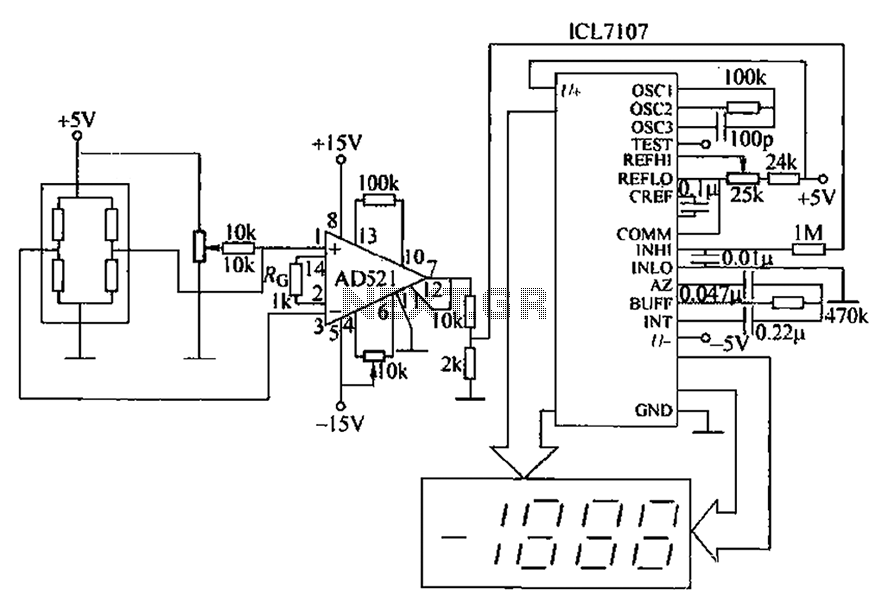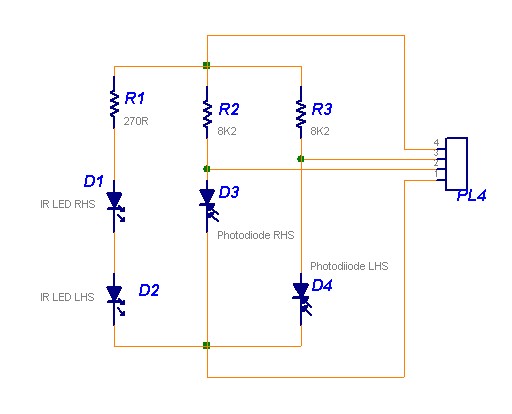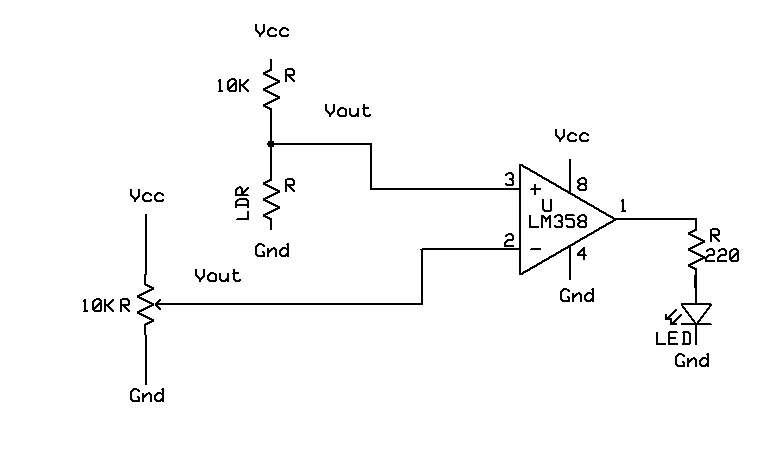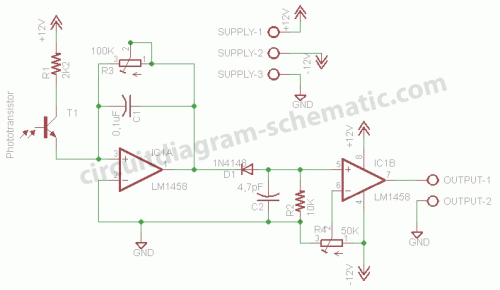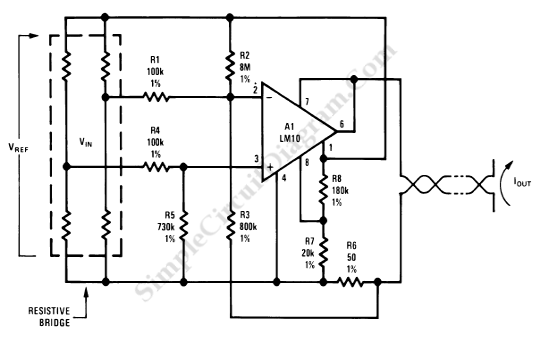
Pulsed-light sensor
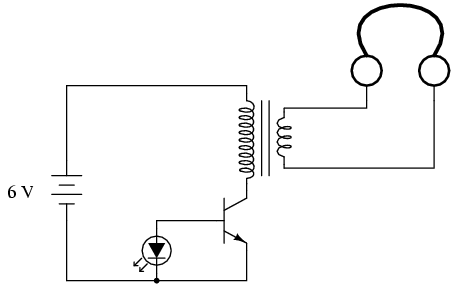
If you do not have an audio detector already constructed, a set of closed-cup audio headphones that completely cover the ears, along with a 120V/6V step-down transformer, can be utilized to create a sensitive audio detector for this experiment. This circuit does not include volume control or overvoltage protection. If an audio detector has not been built as outlined in both the DC and AC experiments chapters, it is advisable to do so, as it is a valuable piece of test equipment for any collection. The circuit detects pulses of light striking the LED and converts them into relatively strong audio signals audible through the headphones. According to Forrest Mims, LEDs can generate current when exposed to light, similar to a semiconductor solar cell. The LED alone does not produce sufficient electrical power to drive the audio detector circuit, necessitating the use of a transistor to amplify the signals from the LED. When the LED is exposed to a pulsing light source, a tone will be heard in the headphones. Suitable light sources for this experiment include fluorescent and neon lamps, which blink rapidly due to the 60 Hz AC power. Additionally, bright sunlight can be used as a steady light source, with the effect of waving fingers in front of the LED causing the generation of voltage pulses and a brief "buzzing" sound in the headphones. LEDs function as narrow-band devices, responding to specific wavelengths of light. Infrared remote controls provide an effective illumination source for near-infrared LEDs used as photo-sensors, producing audible signals. With some creativity, the concept of transmitting audio information, such as music or speech, over a beam of pulsing light can be easily understood. A suitable transmitter circuit can pulse an LED on and off with the positive and negative crests of an audio waveform from a microphone, while the receiver circuit described here converts the light pulses back into audio signals.
The audio detector circuit described utilizes a light-emitting diode (LED) as the core sensing element. The LED, when exposed to varying light conditions, generates small electrical signals that require amplification for audible output. The circuit is initiated by connecting the LED to a transistor configured as a common emitter amplifier. The transistor amplifies the small current generated by the LED, allowing it to drive the headphones effectively.
In practical implementation, the circuit can be powered using a 120V to 6V step-down transformer, which ensures that the voltage supplied to the circuit is safe and manageable. The transformer is connected to the mains supply, and its output is fed into the circuit, providing the necessary voltage to the LED and transistor.
The LED is positioned to face the light source, and its sensitivity can be adjusted based on the ambient light conditions. For optimal performance, the circuit can be enclosed in a housing that minimizes external light interference while allowing the desired light source to reach the LED. The headphones are connected to the output of the transistor, where the amplified audio signal is delivered.
This audio detector circuit is particularly effective with light sources that produce rapid fluctuations in intensity, such as fluorescent and neon lamps. The 60 Hz flicker of these lamps creates a pulsing effect that the LED can detect, resulting in an audible tone in the headphones. Additionally, the circuit can be tested outdoors using sunlight, where moving objects can create varying light conditions that the LED can pick up.
The ability of LEDs to function as both light emitters and detectors opens up possibilities for innovative applications, including wireless audio transmission. By integrating a suitable transmitter circuit that modulates the LED with an audio input, it becomes feasible to transmit sound over a light beam, which the described receiver circuit can then decode back into audible signals. This principle underlies many optical communication systems and can be a foundational experiment for understanding light-based data transmission.If you don`t have an audio detector already constructed, you can use a nice set of audio headphones (closed-cup style, that completely covers your ears) and a 120V/6V step-down transformer to build a sensitive audio detector without volume control or overvoltage protection, just for this experiment. If you haven`t made an audio detector as outlined in both the DC and AC experiments chapters, you really should - it is a valuable piece of test equipment for your collection. This circuit detects pulses of light striking the LED and converts them into relatively strong audio signals to be heard through the headphones. Forrest Mims teaches that LEDs have the ability to produce current when exposed to light, in a manner not unlike a semiconductor solar cell.
[MIM] By itself, the LED does not produce enough electrical power to drive the audio detector circuit, so a transistor is used to amplify the LED`s signals. If the LED is exposed to a pulsing source of light, a tone will be heard in the headphones. Sources of light suitable for this experiment include fluorescent and neon lamps, which blink rapidly with the 60 Hz AC power energizing them.
You may also try using bright sunlight for a steady light source, then waving your fingers in front of the LED. The rapidly passing shadows will cause the LED to generate pulses of voltage, creating a brief "buzzing" sound in the headphones.
LEDs serving as photo-detectors are narrow-band devices, responding to a narrow band of wavelengths close, but not identical, to that normally emitted. Infrared remote controls are a good illumination source for near-infrared LEDs employed as photo-sensors, producing a receiver sound.
[MIM3] With a little imagination, it is not difficult to grasp the concept of transmitting audio information - such as music or speech - over a beam of pulsing light. Given a suitable "transmitter" circuit to pulse an LED on and off with the positive and negative crests of an audio waveform from a microphone, the "receiver" circuit shown here would convert those light pulses back into audio signals.
[MIM2] 🔗 External reference
The audio detector circuit described utilizes a light-emitting diode (LED) as the core sensing element. The LED, when exposed to varying light conditions, generates small electrical signals that require amplification for audible output. The circuit is initiated by connecting the LED to a transistor configured as a common emitter amplifier. The transistor amplifies the small current generated by the LED, allowing it to drive the headphones effectively.
In practical implementation, the circuit can be powered using a 120V to 6V step-down transformer, which ensures that the voltage supplied to the circuit is safe and manageable. The transformer is connected to the mains supply, and its output is fed into the circuit, providing the necessary voltage to the LED and transistor.
The LED is positioned to face the light source, and its sensitivity can be adjusted based on the ambient light conditions. For optimal performance, the circuit can be enclosed in a housing that minimizes external light interference while allowing the desired light source to reach the LED. The headphones are connected to the output of the transistor, where the amplified audio signal is delivered.
This audio detector circuit is particularly effective with light sources that produce rapid fluctuations in intensity, such as fluorescent and neon lamps. The 60 Hz flicker of these lamps creates a pulsing effect that the LED can detect, resulting in an audible tone in the headphones. Additionally, the circuit can be tested outdoors using sunlight, where moving objects can create varying light conditions that the LED can pick up.
The ability of LEDs to function as both light emitters and detectors opens up possibilities for innovative applications, including wireless audio transmission. By integrating a suitable transmitter circuit that modulates the LED with an audio input, it becomes feasible to transmit sound over a light beam, which the described receiver circuit can then decode back into audible signals. This principle underlies many optical communication systems and can be a foundational experiment for understanding light-based data transmission.If you don`t have an audio detector already constructed, you can use a nice set of audio headphones (closed-cup style, that completely covers your ears) and a 120V/6V step-down transformer to build a sensitive audio detector without volume control or overvoltage protection, just for this experiment. If you haven`t made an audio detector as outlined in both the DC and AC experiments chapters, you really should - it is a valuable piece of test equipment for your collection. This circuit detects pulses of light striking the LED and converts them into relatively strong audio signals to be heard through the headphones. Forrest Mims teaches that LEDs have the ability to produce current when exposed to light, in a manner not unlike a semiconductor solar cell.
[MIM] By itself, the LED does not produce enough electrical power to drive the audio detector circuit, so a transistor is used to amplify the LED`s signals. If the LED is exposed to a pulsing source of light, a tone will be heard in the headphones. Sources of light suitable for this experiment include fluorescent and neon lamps, which blink rapidly with the 60 Hz AC power energizing them.
You may also try using bright sunlight for a steady light source, then waving your fingers in front of the LED. The rapidly passing shadows will cause the LED to generate pulses of voltage, creating a brief "buzzing" sound in the headphones.
LEDs serving as photo-detectors are narrow-band devices, responding to a narrow band of wavelengths close, but not identical, to that normally emitted. Infrared remote controls are a good illumination source for near-infrared LEDs employed as photo-sensors, producing a receiver sound.
[MIM3] With a little imagination, it is not difficult to grasp the concept of transmitting audio information - such as music or speech - over a beam of pulsing light. Given a suitable "transmitter" circuit to pulse an LED on and off with the positive and negative crests of an audio waveform from a microphone, the "receiver" circuit shown here would convert those light pulses back into audio signals.
[MIM2] 🔗 External reference
